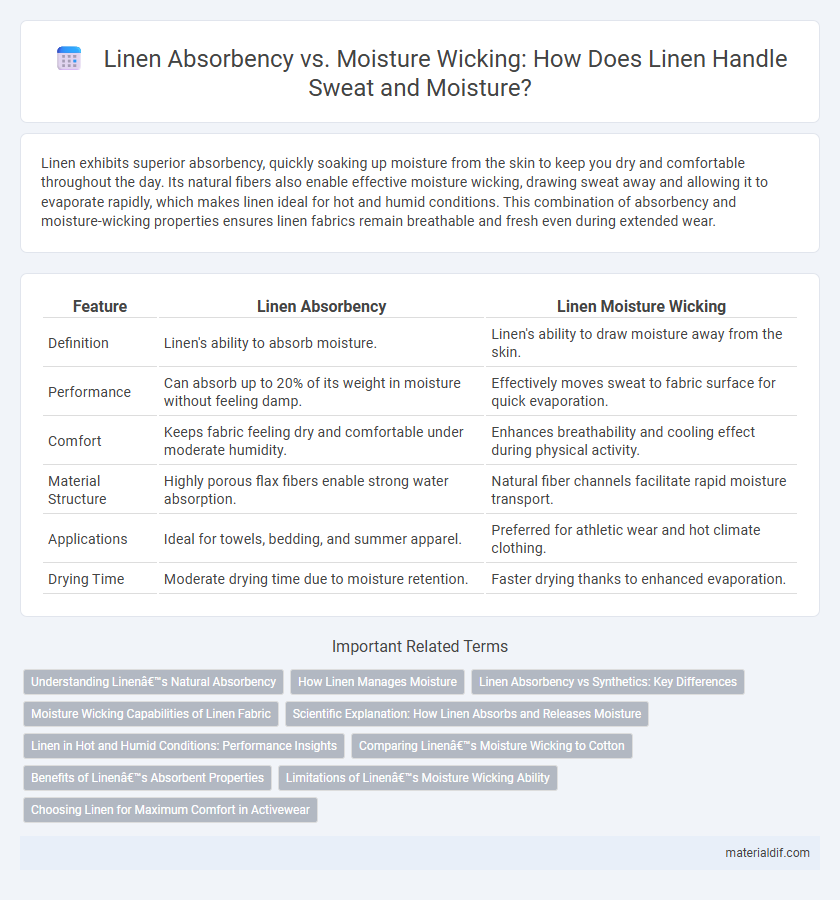Linen exhibits superior absorbency, quickly soaking up moisture from the skin to keep you dry and comfortable throughout the day. Its natural fibers also enable effective moisture wicking, drawing sweat away and allowing it to evaporate rapidly, which makes linen ideal for hot and humid conditions. This combination of absorbency and moisture-wicking properties ensures linen fabrics remain breathable and fresh even during extended wear.
Table of Comparison
| Feature | Linen Absorbency | Linen Moisture Wicking |
|---|---|---|
| Definition | Linen's ability to absorb moisture. | Linen's ability to draw moisture away from the skin. |
| Performance | Can absorb up to 20% of its weight in moisture without feeling damp. | Effectively moves sweat to fabric surface for quick evaporation. |
| Comfort | Keeps fabric feeling dry and comfortable under moderate humidity. | Enhances breathability and cooling effect during physical activity. |
| Material Structure | Highly porous flax fibers enable strong water absorption. | Natural fiber channels facilitate rapid moisture transport. |
| Applications | Ideal for towels, bedding, and summer apparel. | Preferred for athletic wear and hot climate clothing. |
| Drying Time | Moderate drying time due to moisture retention. | Faster drying thanks to enhanced evaporation. |
Understanding Linen’s Natural Absorbency
Linen's natural absorbency stems from its fiber structure, allowing it to absorb up to 20% of its weight in moisture without feeling damp. This high absorbency makes linen ideal for warm climates as it quickly soaks up sweat while staying comfortable against the skin. Unlike synthetic fabrics, linen also promotes quick drying through moisture wicking, which draws moisture away from the body to the fabric's surface where it evaporates.
How Linen Manages Moisture
Linen excels in moisture management due to its natural fiber structure, which allows it to absorb up to 20-25% of its weight in moisture without feeling damp. Unlike moisture-wicking fabrics that actively pull sweat away from the skin, linen's porous fibers quickly absorb and release moisture through evaporation, keeping the wearer cool and dry. This balance of absorbency and breathability makes linen ideal for hot, humid climates and active wear.
Linen Absorbency vs Synthetics: Key Differences
Linen exhibits superior absorbency compared to most synthetic fibers, capable of absorbing up to 20% of its weight in moisture without feeling damp, making it ideal for hot and humid climates. Unlike synthetics, which often trap moisture on the surface due to poor absorption, linen draws moisture away from the skin while allowing it to evaporate quickly, enhancing breathability and comfort. This natural fiber's exceptional moisture-wicking ability combined with high absorbency sets it apart as a durable, breathable alternative to moisture-retaining synthetic fabrics.
Moisture Wicking Capabilities of Linen Fabric
Linen fabric excels in moisture wicking due to its natural fiber structure, which allows it to quickly draw sweat away from the skin and disperse it across the fabric surface for faster evaporation. Unlike other textiles, linen's hollow fibers enhance airflow and breathability, preventing moisture buildup and maintaining a dry, comfortable feel throughout wear. This superior moisture-wicking ability makes linen especially suitable for warm climates and active lifestyles.
Scientific Explanation: How Linen Absorbs and Releases Moisture
Linen fibers possess a unique molecular structure characterized by cellulose chains with abundant hydroxyl groups, enabling high moisture absorbency through hydrogen bonding with water molecules. This hydrophilic nature allows linen to absorb up to 20-25% of its weight in moisture without feeling damp, effectively drawing perspiration away from the skin. Once the ambient conditions change, linen releases absorbed moisture rapidly due to its high fiber crystallinity and capillary action, promoting quick drying and maintaining comfort.
Linen in Hot and Humid Conditions: Performance Insights
Linen excels in hot and humid conditions due to its superior absorbency, capable of absorbing up to 20% of its weight in moisture without feeling damp. Unlike synthetic fabrics, linen fibers allow efficient moisture wicking, drawing sweat away from the skin to promote rapid evaporation and maintain comfort. This combination of high absorbency and effective moisture management makes linen an ideal fabric for breathable, cooling clothing in tropical climates.
Comparing Linen’s Moisture Wicking to Cotton
Linen exhibits superior moisture-wicking properties compared to cotton, efficiently drawing sweat away from the skin to promote faster evaporation and enhanced breathability. Its natural fiber structure creates channels that transport moisture, keeping the wearer dry and comfortable even in humid conditions. Cotton, while absorbent, tends to retain moisture, which can lead to a heavier, damp feel during prolonged wear.
Benefits of Linen’s Absorbent Properties
Linen's superior absorbency allows it to quickly draw moisture away from the skin, enhancing comfort in warm and humid conditions. This natural fiber can absorb up to 20% of its weight in water without feeling damp, preventing the buildup of sweat and reducing the risk of skin irritation. Its moisture-wicking ability promotes breathability and helps maintain a dry, cool feeling throughout the day, making linen ideal for summer clothing and bedding.
Limitations of Linen’s Moisture Wicking Ability
Linen exhibits high absorbency due to its natural fibers, effectively soaking up moisture and providing a cooling sensation. However, its moisture-wicking ability is limited because linen fibers do not transport moisture away from the skin as efficiently as synthetic fabrics or wool. This limitation can result in slower drying times and reduced comfort during intense physical activity or high humidity conditions.
Choosing Linen for Maximum Comfort in Activewear
Linen's exceptional absorbency allows it to quickly soak up sweat, keeping the skin dry during intense activities, while its natural fibers promote superior moisture wicking that draws perspiration away from the body. This combination ensures optimal breathability and comfort, making linen an ideal fabric choice for activewear designed to enhance performance and reduce irritation. Choosing linen for activewear leverages its eco-friendly properties alongside durable wearability, providing both comfort and sustainability in high-intensity environments.
Linen Absorbency vs Moisture Wicking Infographic

 materialdif.com
materialdif.com